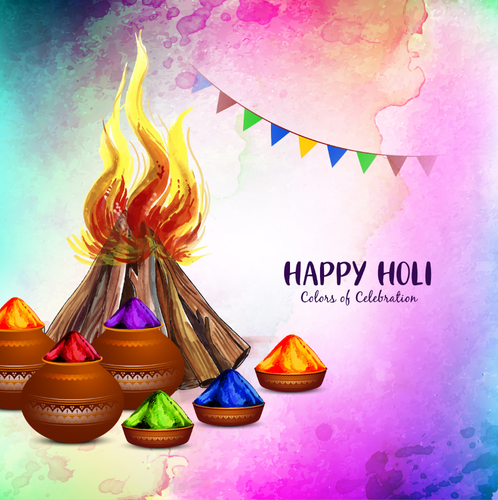
Holi, known as the Festival of Colors, is one of the most vibrant and joyous celebrations in India. This festival, which marks the arrival of spring and the end of winter, is celebrated on the full moon day in the Hindu month of Phalguna (February-March). Holi is a time of merrymaking, where people from all walks of life come together to play with colors, sing, dance, and enjoy festive foods. It symbolizes the triumph of good over evil, the arrival of spring, and a time for rejuvenation and renewal.
Historical and Mythological Significance
Holi has a rich historical and mythological background:
The Legend of Holika and Prahlad: One of the most popular legends associated with Holi is that of Holika and Prahlad. Prahlad, a devout follower of Lord Vishnu, was the son of the demon king Hiranyakashipu, who considered himself a god and demanded that everyone worship him. However, Prahlad refused and continued to worship Vishnu. Enraged, Hiranyakashipu tried to kill his son multiple times but failed. Finally, he asked his sister Holika, who had a boon that made her immune to fire, to sit with Prahlad in a blazing fire. However, due to her evil intentions, Holika was burned to ashes while Prahlad emerged unharmed. This story symbolizes the victory of good over evil.
Krishna and Radha: Holi is also associated with the divine love of Lord Krishna and Radha. According to legend, young Krishna, who was dark-skinned, was worried that Radha would not like him because of his complexion. His mother, Yashoda, suggested that he apply color to Radha’s face to change her complexion. This playful act became a tradition and is celebrated with great enthusiasm in the region of Braj, encompassing Mathura, Vrindavan, and Barsana.
Kaamadeva’s Sacrifice: Another story related to Holi is that of Kaamadeva, the god of love. According to legend, Shiva was in deep meditation, and to awaken him, Kaamadeva shot an arrow of love. Shiva, in his rage, opened his third eye and burned Kaamadeva to ashes. However, upon seeing Kaamadeva’s wife Rati’s sorrow, Shiva restored him, thus symbolizing the importance of love and sacrifice.
Rituals and Customs
Holi is celebrated with various rituals and customs, which add to the charm and excitement of the festival:
Holika Dahan: The festivities begin with Holika Dahan, also known as Chhoti Holi, on the eve of the main festival. People gather around a bonfire to perform rituals, symbolizing the burning of evil and the triumph of good. This ritual represents the burning of Holika and the survival of Prahlad. The bonfire is lit in the evening, and people offer grains, popcorn, coconut, and sweets as a mark of respect.
Playing with Colors: The main day of Holi, known as Rangwali Holi or Dhulandi, is all about playing with colors. People smear each other with colored powders (gulal) and throw colored water using pichkaris (water guns) and balloons. The air is filled with laughter, music, and shouts of “Holi Hai!” as people, irrespective of age, gender, or social status, join in the fun.
Traditional Delicacies: Holi is also a time to indulge in traditional delicacies. Special sweets like gujiya (a sweet dumpling filled with khoya and dry fruits), malpua (a type of pancake), and thandai (a spiced milk drink) are prepared and enjoyed. Bhang, an intoxicating drink made from cannabis leaves, is also consumed in some regions, adding to the festive spirit.
Music and Dance: Music and dance are integral to Holi celebrations. Traditional folk songs, known as Holi geet, are sung, and people dance to the beats of drums and dholaks. In some regions, particularly in Braj, the Lathmar Holi is celebrated where women playfully hit men with sticks (lathis) while the men protect themselves with shields.
Community Gathering: Holi fosters a sense of community and togetherness. People visit friends and family, exchange sweets, and embrace each other, forgetting past grievances and renewing relationships. It is a time to forgive and forget, to laugh and play, and to spread happiness and love.
Regional Variations
Holi is celebrated with different customs and traditions across various regions of India:
Lathmar Holi in Barsana: In Barsana, the birthplace of Radha, Lathmar Holi is celebrated with great fervor. Women playfully hit men with sticks, and men try to protect themselves. This unique tradition attracts tourists and participants from all over the world.
Phoolon ki Holi in Vrindavan: In Vrindavan, Holi is celebrated with flowers instead of colors. The priests of the Banke Bihari Temple shower devotees with flower petals, creating a divine and mesmerizing atmosphere.
Dol Jatra in West Bengal: In West Bengal, Holi is known as Dol Jatra or Dol Purnima. Idols of Radha and Krishna are placed on a decorated palanquin and taken around the streets, accompanied by singing and dancing. People apply colors to each other and celebrate the festival with great enthusiasm.
Manjal Kuli in Kerala: In Kerala, Holi is known as Manjal Kuli. It is celebrated in the Konkani temple of Gosripuram Thirumala. People splash turmeric water on each other and celebrate with traditional songs and dances.
Shigmo in Goa: In Goa, Holi is celebrated as Shigmo, a festival of colors, music, and dance. Parades with traditional folk dances and performances are held, and people play with colors, celebrating the arrival of spring.
Spiritual and Social Significance
Holi holds immense spiritual and social significance:
Triumph of Good over Evil: Holi is a celebration of the victory of good over evil, as symbolized by the legend of Holika and Prahlad. It reminds people of the power of faith and devotion and encourages them to uphold righteousness.
Renewal and Rejuvenation: The festival marks the end of winter and the arrival of spring, a season of renewal and rejuvenation. It signifies the blooming of nature, new beginnings, and the rejuvenation of life and relationships.
Social Harmony: Holi breaks down social barriers and fosters a sense of unity and brotherhood. People from different backgrounds, castes, and religions come together to celebrate, promoting social harmony and inclusiveness.
Cultural Heritage: Holi is a celebration of India’s rich cultural heritage. The music, dance, traditional foods, and regional variations reflect the diversity and vibrancy of Indian culture.
Modern-Day Celebrations
In modern times, Holi has gained popularity not only in India but also globally. The festival is celebrated by Indian communities abroad and has been embraced by people of various cultures. Color runs, music festivals, and community events are organized in many countries, spreading the joy and spirit of Holi worldwide.
While the essence of Holi remains the same, contemporary celebrations have also seen some changes. Eco-friendly practices are being adopted, with natural and organic colors replacing synthetic ones to protect the environment and people’s health. Virtual celebrations have also become popular, especially during times when physical gatherings are not possible.
Conclusion
Holi is a festival that transcends religious and cultural boundaries, bringing people together in a spirit of joy, love, and unity. It is a time to celebrate the colors of life, the triumph of good over evil, and the arrival of spring. Through its vibrant rituals and customs, Holi fosters social harmony, rejuvenates relationships, and celebrates the rich cultural heritage of India.
As people come together to play with colors, sing, dance, and enjoy festive foods, Holi serves as a reminder of the importance of love, forgiveness, and togetherness. It is a festival that truly embodies the spirit of life, spreading happiness and positivity wherever it is celebrated.
